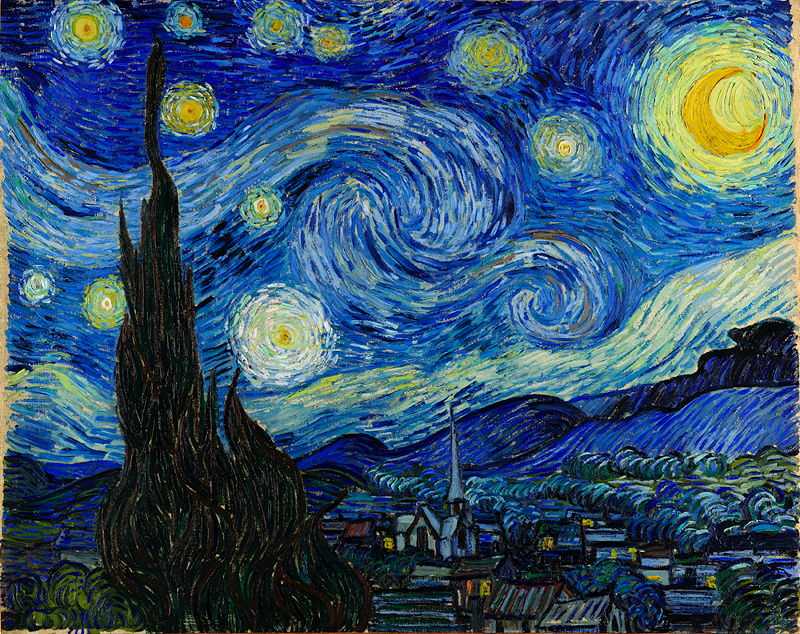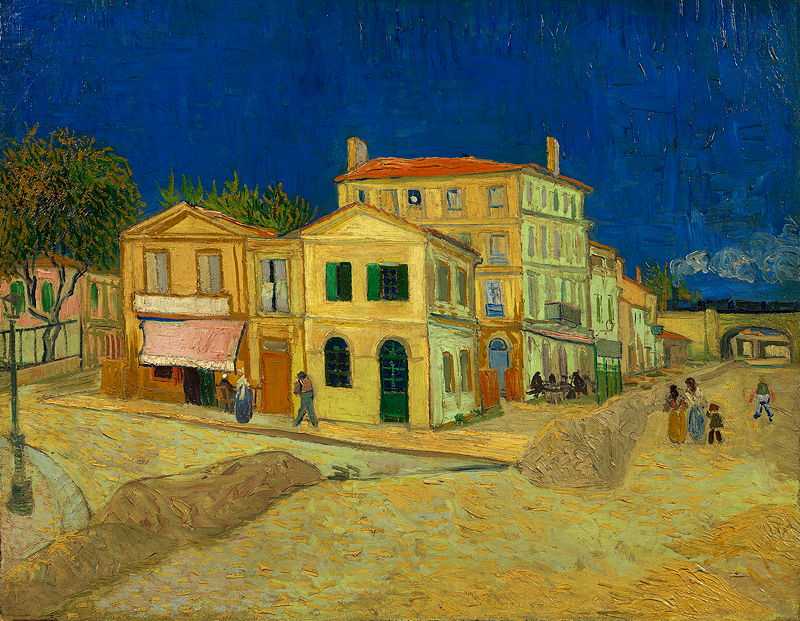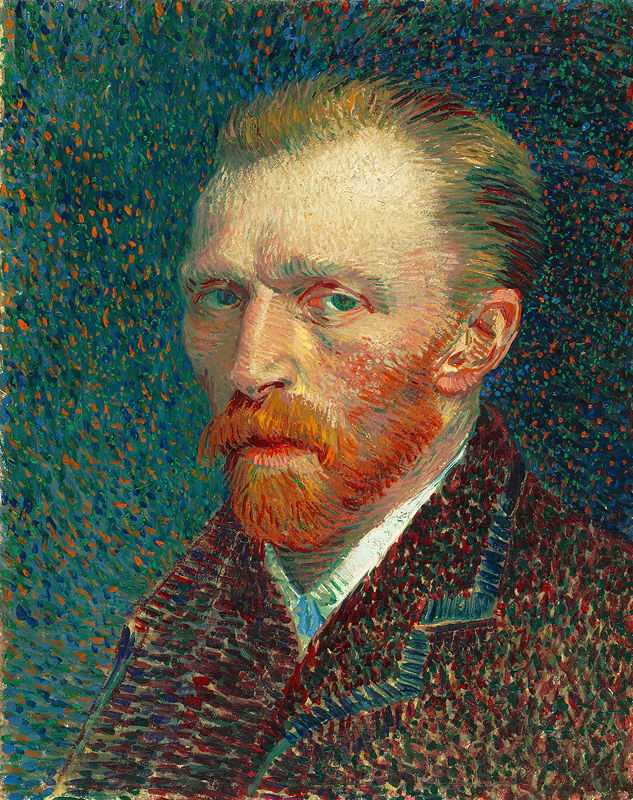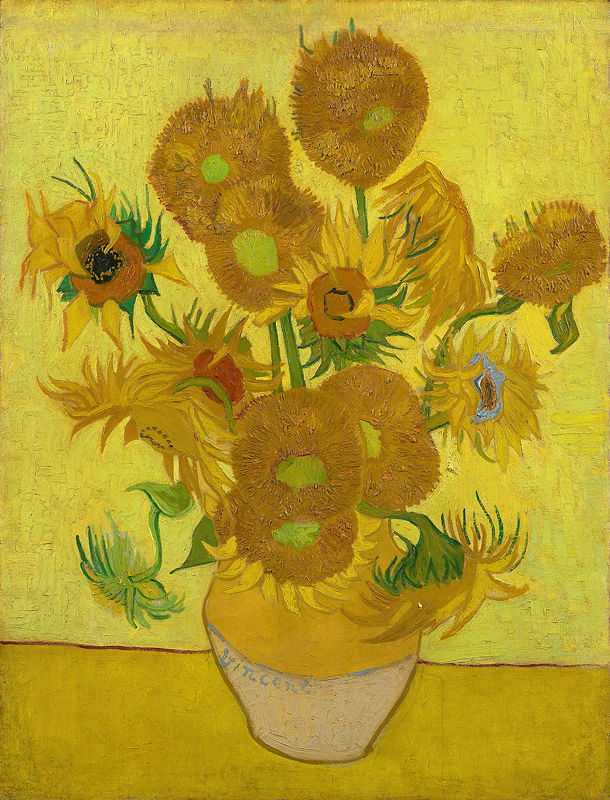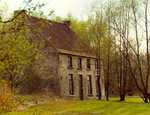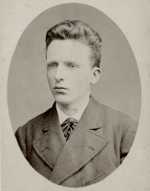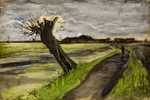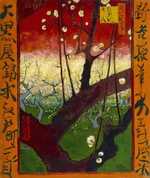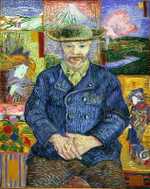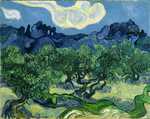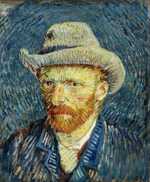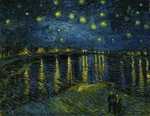1. Van Gogh: a Brief Bio
Van Gogh was a troubled genius: he moved from place to place and from job to job over his adult life.
We can divide his life into five key periods:
(1) 1853 to 1868. Van Gogh was born to austere, religious parents. But his wider family had connections in the art world. His younger brother, Theo, was to become a major source of solace and encouragement in Vincent's life.
(2) 1868 to 1880. Van Gogh had a number of jobs and travelled around Europe. He made a success of ten years as an art dealer before becoming depressed and turning to religion.
(3) 1880 to 1886. Van Gogh decides to commit himself to art but follows the Dutch realist tradition, with its earthy tones.
(4) 1886 to 1888. Van Gogh moves to Paris to be close to his brother and is influenced by impressionist movement. His palette becomes brighter and his works bolder.
(5) 1888 to 1890. Van Gogh moves to the South of France, sets up home with Paul Gauguin and paints virtually all of his most famous works. He is in and out of psychiatric hospitals before committing suicide in July 1890 by shooting himself in the chest.
Van Gogh’s family
Vincent’s parents were highly religious but his wider family certainly had a creative, artistic streak. His father, Theodorus van Gogh was a member of the clergy. His mother, Anna Cornelia Carbentus, was the daughter of bookbinder to the King, Willem Carbentus.
Both married fairly late, having been introduced by Anna’s younger sister, Cornelia, who married the art dealer also called Vincent van Gogh (but who went by the name Cent).
Cent and was the wealthy owner of an art store, which soon developed into a gallery in its own right. Shortly after the marriage of Cent and Cornelia, Theodorus and Anna announced their engagement. Their first child was named after Vincent, as Cent and Cornelia were unable to have children of their own. However, young Vincent died at birth.
A year later, in 1853, another baby boy was born and he was given the same name: Vincent. This was the child that would grow up to become the artist we know and love today.
Anna was an amateur artist herself, drawing many studies of plants and flowers in her garden and during her walks around the town. She insisted that her children walk with her and spend time working in the garden, believing it was important for good health.
These early lessons from Anna may have influenced van Gogh’s later still life works, including his famous Sunflowers series from 1887 and 1888.
Theo
Theo van Gogh was born in May 1837, four year Vincent's junior. Much of what we know about van Gogh today comes from Vincent's correspondence with Theo.
As importantly, Theo was a near constant source of support, encouragement and money for Vincent. As we explain below, Theo also introduced Vincent to the impressionists still in Paris in 1886.
Van Gogh’s first jobs
Vincent excelled at learning languages but showed no early affinity for art.
In 1868, at the age of 15, he abandoned his schooling and never went back. The following year he became an apprentice with Goupil & Cie, an art dealership in Paris that his uncle was affiliated with.
Perhaps surprisingly, judging from what we know now about his later life, Vincent did well as an art dealer, working with the company for almost 10 years. However, upon moving to their London office, Vincent became heavily depressed and was eventually dismissed by the firm.
After a brief time pursuing a career in the clergy in the late 1870s, where Vincent donated all his possessions to coal-miners in South Belgium and was rejected from the church for being too extreme in his piety, he finally settled on becoming an artist.
His reason for seeking out the career was a method of bringing him closer to God.
2. Vincent and Theo
Vincent’s younger brother, Theo, also became art dealer. Four years his junior, Theo supported van Gogh financially for much of his life.
He paid for van Gogh’s move to the Hague, after his decision to become an artist, and rented a studio for him there. At this time, van Gogh began studying under Anton Mauve, his first form of artistic training.
Theo’s early career
Theo started working in Brussels in 1873, employed by his uncle, Hendrick van Gogh, who had moved to The Hague to run his brother Vincent’s art gallery. Not long afterwards, Theo began working for Goupil & Co. and he was sent to Paris to cover the 1878 World Fair.
Whilst in Paris, Theo spent time with his brother. The two were extremely close and shared an enthusiasm for art. Goupil & Co. was an internationally recognised Parisian brand, acting as a merchant for paintings and engravings in Europe and the U.S. In 1880, Theo became the director of Goupil & Co’s Paris branch and he settled in the city permanently. It was thanks to Theo’s residence in the city that van Gogh came for a brief two years.
Goupil & Co was renamed Boussod, Valadon & Cie in 1886, following the retirement of Adolphe Goupil. The company maintained certain guidelines for art dealers working under them but were more inclined towards recent developments in painting than they previously had been. Consequently, Theo had a lot of freedom to promote the artists he wanted.
This was a crucial shift as he was able to begin focussing on the emerging Impressionist artists, as well as the figures who would become the Post-Impressionists. Gauguin was one of Theo’s closest connections and he supported Gauguin financially, as well as helping to find buyers for his work.
Theo and the Impressionists
Around this time, the Impressionists were beginning to gain more publicity. Their principal dealer, Paul Durand-Ruel was struggling financially, however, and Theo was able to capitalise on the market for Impressionist paintings. The first Impressionist artwork he bought was a canvas by Alfred Sisley.
This fortuitous turn of events then saw Theo purchase a large number of paintings by Monet, reaching about 70 artworks in total. He deliberately targeted and promoted Monet as the symbol of the Impressionist movement, placing all the focus of his clients on one artist. This allowed him to distinguish Monet’s work from the others, providing a singular message for collectors new to the movement.
Theo also had a close relationship with Pissarro and Degas, both of whom he showed using independent exhibitions. Pissarro had a solo exhibition organised by Theo in 1890 and Degas in 1888 and 1889, a small, intimate exhibition of his nude paintings. It was this relationship with Pissarro that led to van Gogh’s initial introduction.
Theo tries to sell van Gogh’s paintings
Interestingly, Theo struggled to sell any of his brother’s paintings, despite considerable effort. Van Gogh frequently accused Theo of not making enough effort. In fact, it was purely down to taste - Vincent’s dark palette was not what buyers were looking for.
The Potato Eaters
This is evident from one of van Gogh's earliest masterpieces, a gritty work inspired by the Realist movement and their emphasis on showing the harsh reality of life. ’The Potato Eaters’ from 1885 features a group of peasants sat around a table, depicted in a palette of black and brown.
He deliberately used models who were uglier and more raw than classical artist’s models in an attempt to capture the reality of working-class hardships. The single light source in the painting, a lamp hung in the centre of the table, heightens the bleakness of the scene.
This painting contrasts heavily with the airy, colourful scenes of the Monet, Renoir and many other Impressionists. van Gogh’s deliberate shunning of the beauty and carefree style of the Impressionists showed his commitment to pursuing his own unique style. However, as a result of this individualist attitude, van Gogh was penniless. This canvas was unsellable, despite Theo’s stoic efforts.
3. Van Gogh and the Impressionists
Theo has largely been credited with introducing his brother Vincent to the Impressionists. The pivotal period for van Gogh was during the two years that he spent in Paris, from February 1886 to February 1888.
He moved in with his brother Theo and the two brothers relocated to a larger apartment in the artist’s district.
Van Gogh and Pissarro
Van Gogh quickly found himself drawn into the world of Camille Pissarro, Seurat, Gauguin and other Neo-Impressionist painters, calling them the ‘Painters of the Petit Boulevarde’. These artists were less well established than the likes of Degas and Renoir but nonetheless they had a profound influence on van Gogh’s career. van Gogh particularly liked Pissarro, mentioning frequently in his letters how much he enjoyed their long talks together.
The hopeful artist’s first opinion of Impressionism was not as enthusiastic as one might think, however. He later reflected in a letter to his sister Willemien that people viewing the Impressionists’ work for the first time are often “bitterly, bitterly disappointed and find them careless, ugly, badly painted, badly drawn, bad in colour, everything that's miserable. That was my first impression, too, when I came to Paris”.
Van Gogh is influenced by impressionism
Nevertheless, the influence of the Impressionists had a strong impact on van Gogh. He abandoned the darker styles of his youth and embarked on a new path of emotional, passionate painting, full of brighter colours. This was partly in response to his brother’s pleas and the financial pressure he was under.
The Impressionist style of painting was more commercially viable than his previous works. The contrast can clearly be seen between ‘The Potato Eaters’ of 1885 and the pretty, pithy landscape painting ‘The Hill of Montmarte with Stone Quarry’ from 1886. The latter is light and picturesque, lacking any of the poverty and gloomy character of the former.
From this point onwards, van Gogh’s paintings grew lighter and brighter. Unlike the majority of Impressionist painters, van Gogh did not seek to capture light or natural forms in a realistic way. Instead, his use of light and colour is highly artificial in many paintings, frequently featuring yellow tones with contrasting colours. This is particularly evident in his later works.
Japanese art influence
One of his key inspirations, like many artists at this time, was Japanese art. This influence can be seen in a large number of Impressionist and Post-Impressionist works. ‘The Couresan’ from 1887 is a particularly striking and unusual work that stands out from the rest of his oeuvre. This painting mimics the Japanese wood prints circling Paris, many of which van Gogh and Theo collected together.
He particularly liked the works of Hiroshige and Hokusai and he chose to recreate one painting by Keisai Eisen. van Gogh changed the background, placing the figure on a golden block, layered with a landscape print featuring frogs and cranes. These animals also serve as signifyers of the woman depicted in the painting as both words were French slang for prostitutes.
Similarly, many of van Gogh’s mature paintings have a linear quality to them that mimics Japanese artworks. He combined these strong lines with the loose brushwork of the Impressionists, whilst using his own distinct colour palette. In doing so, van Gogh began creating works that were highly unique and instantly recognisable, differing from any other artist painting at the time.
4. Van Gogh’s later works
Two years in Paris eventually wore him down and van Gogh decided to leave the city, travelling to Arles in the South of France.
He arrived at the town situated on the River Rhône on 20th February, 1888. This move would issue in the most productive period of his life, when many of his most famous works were created.
Van Gogh and Gaugin
Van Gogh moved in with Gauguin, renting a room in ‘The Yellow House’ as it was known. Both artists worked together closely, experimenting with new colour techniques that diverged from the Impressionist style. They began using colour to indicate emotion, leading to paintings like ‘Cafe Terrace At Night’ from 1888.
This work depicts a street scene that van Gogh observed in the town but he added his own flair and psychological undertone to the composition, adding flickering lights to the night sky and painting the cafe a luminous yellow. He said
“[it’s] a painting of night without black. With nothing but beautiful blue, violet and green, and in these surroundings the lighted square is coloured pale sulphur, lemon green.”
From his letter it is clear that he painted the work quickly and in situ, caught in the fleeting moment and thereby following the example of the Impressionists.
In his letters to his sister, van Gogh’s delight in the colours of his new surroundings is clear, as is his creative energy:
“My house here is painted outside in the yellow of fresh butter, with garish green shutters, […] and the floor’s of red bricks. And the intense blue sky above. Inside, I can live and breathe, and think and paint.”
Van Gogh’s ear
However, during this time van Gogh’s mental health began to decline rapidly. It is now thought that he was suffering from epilepsy and bipolar disorder, among other things. When Gauguin announced that he was planning to go abroad, accounts suggest that van Gogh threatened him with a razor before cutting off his own earlobe.
Van Gogh took his severed ear to a brothel in Arles and handed it to a cleaner (contrary to the popular assumption that he gave it to his favourite prostitute). The cleaner fainted and van Gogh retreated to the Yellow House to recover.
Soon afterwards the police were summonsed to the brothel, went to the Yellow House, and, assuming that van Gogh was dead, arrested Gaugin for his murder. He was soon released and van Gogh taken to a local asylum.
The painting ‘Self-Portrait with Bandaged Ear’ from 1889 depicts van Gogh recovering from the act and is one of his most distinctive works.
Van Gogh tries to recover
After Gauguin left France to travel to Tahiti, van Gogh’s precarious mental health declined rapidly. He committed himself to a psychiatric hospital in the nearby town of Saint-Remy.
During his recovery, he painted some of his most-loved works as he immersed himself in his surroundings. In 1889 he painted ‘Starry Night’ entirely from memory. This painting is highly evocative and completely removed from his previous scenes. The swirling sky has a dreamlike quality, created using short, loose brushstrokes.
Van Gogh’s death
Eventually, van Gogh left the clinic and moved to Auvers-sur-Oise, outside of Paris. On the recommendation of Theo, van Gogh went into the care of Dr. Gachet, an amateur artist himself. van Gogh continued to paint until late July 1890, when he left home and walked to a nearby field. It was in this field that he shot himself in the chest.
This was van Gogh's reaction to the news that his brother was hoping to go into business for himself and therefore he wouldn’t be able to support van Gogh as generously as he had done. The change would only be temporary.
Van Gogh died in his Theo’s arms two days later. He left him his entire collection of artworks.
5. Van Gogh’s legacy
Van Gogh is now an internationally recognised artist, revered for his bold, intense colours and emotional, expressive artworks.
His impulsive brushstrokes and flirtation with Impressionist styles make his works striking and unique. His paintings went on to inspire the Fauvinist movement and the Abstract Expressionists of the 20th century.
As an artistic persona, there can be no doubt that van Gogh shaped the image that still exists today of artists tortured by their own creative genius. His legacy consists of tales that have reached almost mythological status, thick with frenzied outbreaks that display the madness of artistic talent.
Most notably, his fateful time spent with Gauguin and the events that led to him losing an ear have contributed to this enduring impression.
Van Gogh’s biography reads as colourful and extreme as his most famous works. It is perhaps one factor that has led to his widespread fame today. However, during his life he was scarcely known at all.
Over the course of his artistic career, van Gogh produced 900 paintings and over 1,100 drawings and sketches. Despite this, his talent went unnoticed by the French art market. He sold just one painting while he was alive.
Van Gogh resources
To take your knowledge to the next level, check out our resources page - you'll find recommendations for the best impressionist books, videos and gifts.

